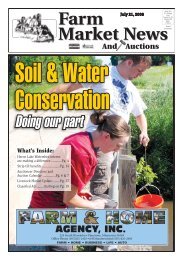to download the Pipestone National Monument 75th Edition.
to download the Pipestone National Monument 75th Edition.
to download the Pipestone National Monument 75th Edition.
Create successful ePaper yourself
Turn your PDF publications into a flip-book with our unique Google optimized e-Paper software.
10 – PIPESTONE COUNTY STAR THURSDAY, AUGUST 16, 2012Prairie Continued from page 8<strong>the</strong> park’s general management plan.“A large chunk of <strong>the</strong> vegetation out here is useful <strong>to</strong><strong>the</strong>m some way or ano<strong>the</strong>r ei<strong>the</strong>r in <strong>the</strong>ir ceremoniesor <strong>the</strong>ir medicines,” he said. “Sage - <strong>the</strong>y would use it in<strong>the</strong>ir kinnikinnik or <strong>to</strong>bacco and <strong>the</strong>y would burn that as acleansing agent before <strong>the</strong>ir ceremonies.”According <strong>to</strong> <strong>Monument</strong> interpretive information onkinnikinnik, it is an Algonquin word meaning “that whichis mixed” and is any combination of common plantssmoked by various Indian tribes in ceremonial pipes.Wild <strong>to</strong>bacco was rarely smoked alone, but mixed withbearberry, spearmint or peppermint and/or a host of o<strong>the</strong>rprairie plants such as prairie rose hips, smooth sumac,white sage and red osier dogwood, among o<strong>the</strong>rs. Eachplant mixture for smoking was a personal choice, having aspecial meaning <strong>to</strong> only one person.Made up of different varieties of warm and cold seasongrasses, <strong>the</strong> tallest grasses - Indian and big blue stem -grow <strong>to</strong> a height of 6-<strong>to</strong>-7 feet and sprout yellow and blueflowers, respectively, Hendriks said. Sideoats grama andlittle blue stem grasses reach heights of about 2-<strong>to</strong>-3 feet,with sideoats grama being bluish-green in color and littleblue stem being a smaller version of <strong>the</strong> big blue stem andsometimes called ‘turkey feet’ or ‘beard grass’ due <strong>to</strong> <strong>the</strong>shape of its seed heads. Depending on <strong>the</strong> season, viewsof <strong>the</strong> prairie can appear yellow, purple, red and orange, hesaid.Among <strong>the</strong> plants living in <strong>the</strong> park are arrowhead, sage,native prairie rose and smooth sumac, a small shrubbytree, whose leaves American Indians would also use inkinnikinnik, Hendriks said.Prescribed burnsA tallgrass prairie does not contain mature trees,Hendriks said. Lightning strikes would ignite sections of <strong>the</strong>vast grasslands and <strong>the</strong> fires would creep along <strong>the</strong> ground,eliminating tree saplings and dead undergrowth. As moreof <strong>the</strong> prairie was settled and turned over for agriculturaluse, prairie fires were extinguished and trees such as oak,elms and ash grew <strong>to</strong> mature heights, making <strong>the</strong>m moreresistant <strong>to</strong> fire, he said.The <strong>Monument</strong> began a rotational prescribed burnsystem about 40 years ago, which mimics Mo<strong>the</strong>r Nature’srole in preserving <strong>the</strong> tallgrass prairie, and burns abou<strong>to</strong>ne-third of its prairie grasses each year, Hendriks said.In 2012, however, wind direction did not cooperate and<strong>the</strong> burn, conducted by <strong>National</strong> Park Service-trainedwildland firefighters, did not take place. He said <strong>the</strong> burningalso places nutrients back in<strong>to</strong> <strong>the</strong> soil, improving <strong>the</strong>grassland’s overall health. The trees currently in <strong>the</strong> park,which grew during <strong>the</strong> timeframe of no prescribed burns,are allowed <strong>to</strong> stay in <strong>the</strong> park, Hendriks said.“It’s supposed <strong>to</strong> be native tallgrass prairie but <strong>the</strong>re is amixture of trees and scrubs in <strong>the</strong>re as well,” Hendriks said.“And exotic and invasive species, of like smooth brome andthistles.”Between burns, <strong>the</strong> park system has put in a system <strong>to</strong>control <strong>the</strong> non-native plants species brought in<strong>to</strong> <strong>the</strong> areaby European settlers, he said.Invasive plant species“We have <strong>to</strong> preserve <strong>the</strong>se areas for enjoyment of futuregenerations,” Hendriks said citing <strong>the</strong> mandate from <strong>the</strong>Organic Act of 1916.For <strong>the</strong> <strong>Monument</strong>, preservation means controlling <strong>the</strong>19 invasive plant species located in <strong>the</strong> park.Hendriks said each summer <strong>the</strong> park service hiresseasonal employees <strong>to</strong> pull or cut invasive plants from <strong>the</strong>tallgrass prairie and/or wetlands before it can reach <strong>the</strong>prairie areas. One such invasive plant, Dame’s rocket, is2-<strong>to</strong>-3-feet in height and has large, fragrant white, purpleor pink flowers located in ditches and under trees.“A lot of people think it’s really pretty but it can take overan area quite quickly if it’s not controlled,” he said. “Thenall you’re going <strong>to</strong> see is that and it is only going <strong>to</strong> flower fortwo <strong>to</strong> three weeks and <strong>the</strong>n it is going <strong>to</strong> be stalks of deadstuff <strong>the</strong> rest of <strong>the</strong> time.”O<strong>the</strong>r invasive plants include European buckthorn, whiteand yellow sweet clover and thistles, Hendriks said.Milkweed, though not native <strong>to</strong> <strong>the</strong> prairie grasslands, isnot an invasive plant and is allowed <strong>to</strong> grow throughout <strong>the</strong>park.“The reason we don’t control it is because of <strong>the</strong> monarchThe western prairie fringed orchid is one of two endangeredspecies existing at <strong>the</strong> <strong>Monument</strong>. The o<strong>the</strong>r is <strong>the</strong>Topeka shiner.population,” Hendriks said. “That’s been struggling latelyand it’s a big food source for <strong>the</strong>m.”Seed ga<strong>the</strong>ringDue <strong>to</strong> <strong>the</strong> unique varieties of prairie grasses at <strong>the</strong><strong>Monument</strong>, Hendriks said <strong>the</strong> last Saturday in September is<strong>the</strong> park service’s Public Lands Day. This year, <strong>the</strong> collectiondate is Sept. 29.For a couple of hours, participants receive instructionson native grasses and spend time hand ga<strong>the</strong>ring variousseeds <strong>to</strong> be used <strong>to</strong> res<strong>to</strong>re disturbed prairie grass areas, hesaid.“We will drill it in <strong>the</strong> ground and let it sit for <strong>the</strong> winterbecause warm season grasses need a winter out <strong>the</strong>re in <strong>the</strong>soil before <strong>the</strong>y come up,” he said.In <strong>the</strong> spring, Hendriks said <strong>the</strong>y would control <strong>the</strong> weedsbecause <strong>the</strong> grasses won’t emerge until June.O<strong>the</strong>r areas may be planted by hand or broadcast using anall-terrain vehicle with an attached seed spreader, Hendrikssaid. Due <strong>to</strong> its unique genetics, only seeds ga<strong>the</strong>red from<strong>the</strong> <strong>Monument</strong> can be planted. This year due <strong>to</strong> <strong>the</strong> summerdrought conditions, <strong>the</strong>re may not be a lot of seed ga<strong>the</strong>red<strong>to</strong> complete as much of <strong>the</strong> tallgrass prairie res<strong>to</strong>ration asplanned, such as res<strong>to</strong>ring native grasses around <strong>the</strong> ThreeMaidens area, he said.Bird counts“We have grassland birds that, if <strong>the</strong>y s<strong>to</strong>p cominghere, we know our prairieland is not in very good health,”Hendriks said.Grassland birds need prairie in order <strong>to</strong> build nests, hesaid, and if <strong>the</strong>y do not have a suitable breeding location<strong>the</strong>y will move <strong>to</strong> ano<strong>the</strong>r location, or may simply die.“And <strong>the</strong>ir populations are declining,” Hendriks said.Each year in late May when <strong>the</strong> birds are mating, hesaid he conducts bird counts <strong>to</strong> know how many speciesare making <strong>the</strong> <strong>Monument</strong> <strong>the</strong>ir home. Hendriks said <strong>the</strong>yhad good counts of dickcissel, sedge wrens, bobolinksand meadowlarks in <strong>the</strong> 68 different moni<strong>to</strong>ring pointsthroughout <strong>the</strong> park during this May’s bird counts.“By doing it in May, we may miss <strong>the</strong> ducks that passthrough when it is wet, but that is not so important because<strong>the</strong> ducks are not breeding here, <strong>the</strong>y are just passingthrough,” he said.Ducks counted this year included pintails, blue-wingteals and wood ducks.Every four years, a U.S. Geological Survey is conductedthat details all birdlife in <strong>the</strong> park, Hendriks said.O<strong>the</strong>r mammals“For mammals, we are a little short, but we have plentyof deer,” he said.Currently, Hendriks said <strong>the</strong> <strong>Monument</strong> does not have amanagement program for <strong>the</strong> limited amount of mammalsliving in <strong>the</strong> 301-acre park. He said a game camera set outlast fall captured images of red fox, woodchucks, raccoons,skunks and ferel cats.“Mammals are more resilient than a lot of o<strong>the</strong>r species,”he said. “They are not a high priority because <strong>the</strong>y canmanage on <strong>the</strong>ir own.”The deer population is moni<strong>to</strong>red by <strong>the</strong> MinnesotaDepartment of Natural Resources and if <strong>the</strong>y start makingnoticeable trails through <strong>the</strong> prairieland, that agency iscontacted for management, Hendriks said.Endangered speciesOn <strong>the</strong> federal threatened and/or endangered species listare two species that are closely moni<strong>to</strong>red by <strong>Monument</strong>staff: <strong>the</strong> Topeka shiner and <strong>the</strong> western prairie fringedorchid.While Lake Hiawatha and Pipes<strong>to</strong>ne Creek do not containgame fish and fishing is not allowed at <strong>the</strong> <strong>Monument</strong>,Hendriks said <strong>the</strong> area contains several bait varieties suchas blue gill and white sucker along with <strong>the</strong> endangeredTopeka shiner.“They decided that this fish was important <strong>to</strong> <strong>the</strong>ecosystem and it needed <strong>to</strong> be protected,” Hendriks said.At <strong>the</strong> <strong>Monument</strong>, <strong>the</strong> threatened orchid is also findinggrowing success.“We counted 722 this year and that’s <strong>the</strong> most we’ve hadsince we began counting,” he said.Thank Youfor 75 years ofPaving <strong>the</strong> WayFULLERPAVING1092 161st St Pipes<strong>to</strong>ne, MNSteve Fuller (507) 825-3226Stan’sElec tric701 2nd St. NE, Pipes<strong>to</strong>ne(507) 825-5352Happy<strong>75th</strong> Anniversary<strong>to</strong> <strong>the</strong>Pipes<strong>to</strong>ne <strong>National</strong><strong>Monument</strong>!915 7th Street SE, Pipes<strong>to</strong>ne, MN 56164507.562.1100866.936.STAYCROSSINGSINN.COMCongratulationsOn YourAchievement of75 Years!Meulebroeck, Taubert& Co., PLLPCertified Public AccountantsPipes<strong>to</strong>ne825-4288Luverne283-4055Russell823-4391Tyler247-3939Lake Wilson879-3538






